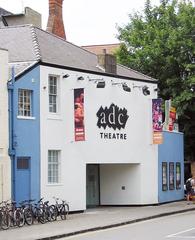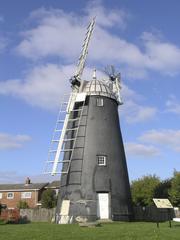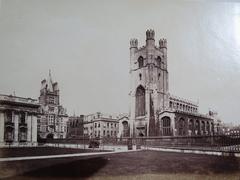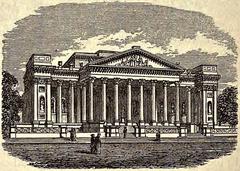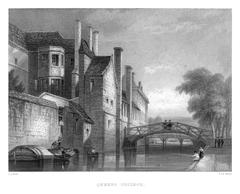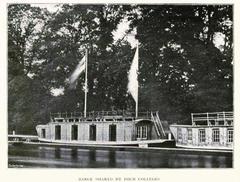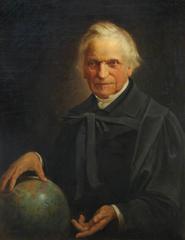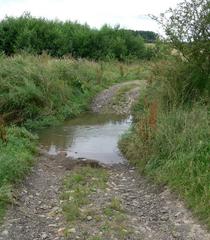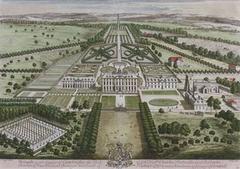Hobson’s Conduit Monument: Visiting Hours, Tickets, and Guide to Cambridge’s Historic Watercourse
Date: 03/07/2025
Introduction
Hobson’s Conduit stands as a remarkable testament to Cambridge’s heritage, blending early modern engineering, civic collaboration, and public health innovation. Built in the early 17th century, this pioneering watercourse system brought vital clean water from the springs at Nine Wells into the heart of Cambridge, transforming urban sanitation and shaping the city’s development. Today, the Hobson’s Conduit Monument and the open water runnels along Trumpington Street offer visitors a direct connection to this fascinating chapter of the city’s past (Hobson’s Conduit Trust; Cambridge City Council).
This comprehensive guide covers everything you need to plan your visit: historical background, monument features, accessibility, tour options, nearby attractions, and tips for making the most of your exploration of this iconic Cambridge site.
Table of Contents
- Introduction
- Historical Background and Significance
- Monument Features and Engineering Legacy
- Visiting Hours and Ticket Information
- Accessibility
- How to Get There
- Guided Tours and Special Events
- Walking the Conduit Route
- Nearby Attractions and Amenities
- Photography Tips
- Visitor Etiquette and Preservation
- Frequently Asked Questions (FAQ)
- Summary and Visitor Tips
- References
Historical Background and Significance
Origins and Purpose
Constructed between 1610 and 1614, Hobson’s Conduit was a visionary public health project, addressing Cambridge’s dire sanitation problems. The system diverted fresh spring water from Nine Wells, located south of the city, through a network of underground pipes and open channels, supplying clean water to public pumps, markets, colleges, and even the city’s ditches (Historic England; Trumpington Local History Group).
This ambitious endeavor was spearheaded by Thomas Hobson, a local carrier and philanthropist, whose name became synonymous with the project. His legacy endures not only in the monument but also in the English idiom “Hobson’s choice,” reflecting his unique business practices (Wikipedia).
Social and Civic Impact
The conduit played a vital role in reducing waterborne diseases, democratizing access to safe water, and fostering an unusual spirit of cooperation between the University and town authorities. Its success influenced the design of urban water systems across England and continues to symbolize civic ingenuity and public health advancement (Cambridge City Council; Cambridge Water).
Monument Features and Engineering Legacy
The Monument
The Hobson’s Conduit Monument, now at the junction of Trumpington Street and Lensfield Road, is a Grade II* listed structure. Originally built in 1614 as a public fountain in Market Square, it was moved to its current site in 1856. The monument features a classical stone canopy, coats of arms, commemorative inscriptions, and decorative wrought iron railings (Wikipedia; British Listed Buildings).
Architectural and Engineering Details
Designed by Thomas Chaplin, the monument exemplifies early 17th-century civic architecture. The conduit system itself was advanced for its time, using gravity-fed channels and a network of lead and stone pipes to distribute water efficiently across the city. Open runnels along Trumpington Street, still visible today, are a rare urban feature and an enduring symbol of Cambridge’s innovative spirit (Cambridge City Council; Historic England).
Visiting Hours and Ticket Information
- Monument and Runnels: Open-access outdoor site, freely accessible 24/7. No tickets or admission fees are required.
- Nine Wells (Source): The springs and nature reserve at Nine Wells are best visited during daylight hours, typically from 8:00 AM to sunset.
- Guided Tours: Offered periodically by local heritage groups and during special events; check official websites for dates and booking details.
Accessibility
- The monument is located on a flat, paved public pavement, making it accessible to wheelchair users and those with mobility challenges.
- Pedestrian crossings and nearby bus stops ensure safe and convenient access.
- Some sections of the original watercourse and the trail to Nine Wells may involve uneven ground; visitors with limited mobility should plan accordingly (Louise Jayne Munton).
How to Get There
- By Foot/Bicycle: Easily reachable from Cambridge city center, with dedicated cycle parking nearby.
- By Bus: Local buses stop along Trumpington Street and Lensfield Road.
- By Car: Parking is limited in the city center; public transport or walking is recommended. Parking for Nine Wells is available near Addenbrooke’s Hospital.
Guided Tours and Special Events
- Walking Tours: Hobson’s Conduit is featured in many Cambridge historical walking tours, typically alongside university colleges and museums.
- Special Events: The Hobson’s Conduit Trust and local history groups occasionally organize guided walks, talks, and annual community events such as the cleaning of the runnels. Check the Hobson’s Conduit Trust for updates.
Walking the Conduit Route
- City Center Walk: Begin at the Conduit Head monument, follow the water runnels along Trumpington Street and St Andrew’s Street, and end at Market Square. This route passes historic colleges and museums.
- Extended Route to Nine Wells: For a longer excursion, trace the watercourse south to Nine Wells Nature Reserve, the original source. Some sections may not be accessible due to modern development (The Cambridge Placebook; Reddit).
Nearby Attractions and Amenities
- Fitzwilliam Museum: World-class art and antiquities a short walk away.
- Cambridge University Botanic Garden: A tranquil green space near the monument.
- Pembroke and Peterhouse Colleges: Historic university buildings along the conduit’s route.
- Cafés and Restaurants: Numerous options are available in the city center.
- Public Restrooms: Accessible nearby.
Photography Tips
- Capture the monument’s stonework and inscriptions in early morning or late afternoon light.
- The open runnels along Trumpington Street offer dynamic urban waterway scenes.
- Nine Wells provides natural landscapes and a commemorative obelisk for scenic shots.
Visitor Etiquette and Preservation
- Please do not climb on the monument or disturb the water channels.
- Supervise children near open water.
- Support preservation by respecting the site and following posted guidelines (Hobson’s Conduit Trust).
Frequently Asked Questions (FAQ)
Q: Is there an entry fee for visiting Hobson’s Conduit?
A: No, the site is free and open to the public at all times.
Q: Are guided tours available?
A: Yes, through local tour operators and heritage groups; check schedules in advance.
Q: Is the site accessible for wheelchair users?
A: Yes, the monument and main city runnels are accessible; Nine Wells may have uneven terrain.
Q: Can I bring children?
A: Yes, but supervise them near open water channels.
Q: What is the best time to visit?
A: Daylight hours for safety and best visibility; spring through autumn for pleasant weather.
Q: Are dogs allowed?
A: Dogs are permitted in public outdoor areas, but please keep them on a lead near water channels.
Summary and Visitor Tips
Hobson’s Conduit is a captivating window into Cambridge’s history of innovation, public health, and civic unity. The monument, visible water runnels, and nearby Nine Wells springs collectively narrate a story of early modern ingenuity and enduring community spirit. With free admission, year-round accessibility, and proximity to the city’s top attractions, the site makes an excellent addition to any Cambridge itinerary. Guided tours and special events offer deeper insights, while photography enthusiasts will find plenty of inspiration in the monument’s details and urban water scenes.
To enhance your visit, download the Audiala app for interactive maps and audio guides, and check heritage websites for the latest news and event listings. Respect the site to help preserve this unique piece of Cambridge’s legacy for generations to come (Cambridge City Council; Visit Cambridge).
References and Further Reading
- Hobson’s Conduit Trust
- Cambridge City Council
- Historic England
- Cambridge News
- The Edkins Walks
- Trumpington Local History Group
- Visit Cambridge
- Wikipedia
- Louise Jayne Munton
- GPSmyCity
- The Cambridge Placebook
- British Listed Buildings
- BBC
- Cambridge Water
- Oxford English Dictionary
